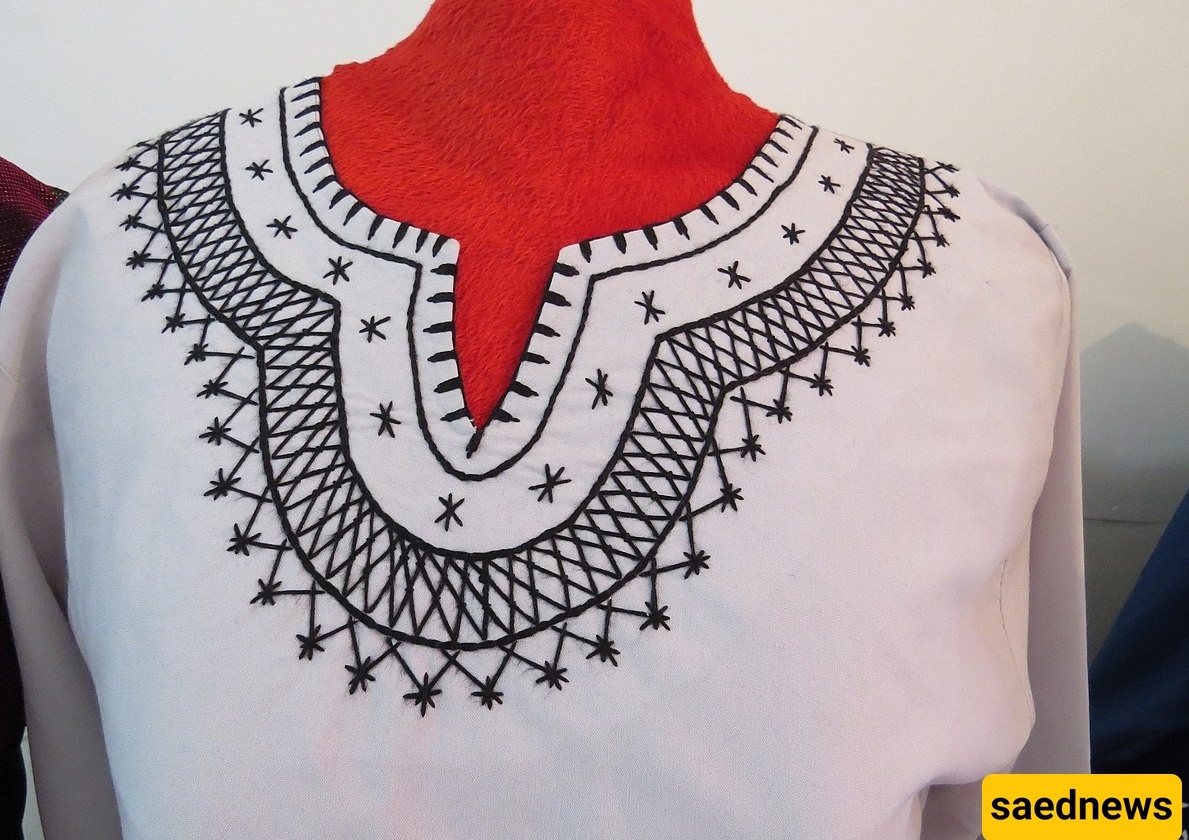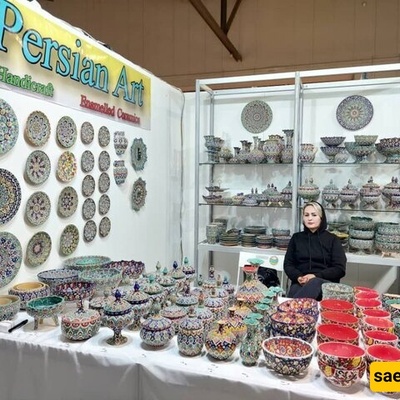Sistan and Baluchestan is a city in Iran where the handicrafts are beautifully showcased by the skilled hands of its people. Black embroidery is one of the types of handicrafts from Sistan, and with Saed News, we get to know it better.

Handicrafts reflect the hardworking spirit of a people like a mirror and bring to life the pursuit of a green life filled with love. Sistan and Baluchestan is a part of ancient and historic Iran that preserves a collection of historical and cultural monuments of this land dating back nearly 150,000 years. The unique handicrafts of the desert region of Sistan and Baluchestan are examples of relics from an ancient civilization, where the artist imprints the soul and passion onto fabric and pottery.
Black Embroidery (Siah Doozi)
Black embroidery is a type of needlework from the Sistan region used to decorate the front chest and cuffs of garments, using only black thread, usually silk. It is an authentic form of embroidery practiced by Sistani women. Siah Doozi in Sistan is another form of embroidery that uses black silk thread applied to clothing. Both Khameh Doozi (thread embroidery) and Siah Doozi have traditionally been mostly for personal use and commonly traded among the people of Sistan. Although historically used to decorate men’s and women’s clothing, today Siah Doozi can also be used to embellish other garments.

History
The arrival of the Scythians (Saka) brought significant changes to Sistan and Baluchestan, including in local weaving, which was influenced by their art. This people produced carpets, kilims, and felt mats as early as the 5th century BCE. The fame of Sistan’s textiles during the Islamic period points to a longstanding artistic heritage. The nomadic people lived in tents and used kilims as rugs, cushions, and bags for flour, bread, salt, etc., decorated with beads, shells, coins, tassels, and gemstones. The history of this craft coincides with the introduction of silk to Sistan. Early Islamic writings note that Sistan was a center for the production of high-quality silk and wool textiles. Sistan, with its abundant mulberry gardens, was one of the largest silk-producing centers. Historical records show workshops for silk cocoon and silk production in the village of Chelang near Zabol even 100 years ago. The peak of this craft, like other Sistan arts, dates back to the Parthian and Sassanian periods.
Siah Doozi is a form of embroidery used to decorate the front chest and sleeve cuffs in Sistan and Baluchestan. Only black silk thread is used, sewn in a tightly joined zigzag (dental) pattern, forming triangular motifs on the fabric. Traditionally, women’s clothing in Sistan was light-colored and white, made from cotton fabric woven by Sistani women themselves. The traditional outfit included a loose shirt (Paner), three layered skirts to protect against the strong winds while maintaining modesty, a vest (basket), and a silk headscarf (Lachak) tied around the forehead. Today, women’s traditional clothes in Sistan are mostly white, reflecting the region’s hot climate—light colors repel heat, while dark colors absorb it; thus, from ancient times, people have preferred light colors, even men wear white.
Women’s clothing is embroidered with Siah Doozi on the front neckline, sleeve cuffs, trouser hems (Poochak), and the bottom of the skirts. Sometimes Khameh Doozi (thread embroidery) is also used, mostly for men’s clothing. Women’s skirts are made from fabric with small floral patterns or plain fabrics. The Paner shirt is often floral and gathered at the waist with a tie. Lachak is a black silk local scarf. The women’s trousers (Tomun) are embroidered with Siah Doozi on the hems. According to some archaeologists, this is the first form of needlework in Iran and is the basis of all embroidery styles.
Today, in Baluchestan, handicrafts such as carpet weaving, bag making, embroidery, coin and button sewing, parwardozi, Siah Doozi, pottery, and jewelry making are common family trades. Historical books and documents mention Siah Doozi, indicating its longstanding history. For example, training in Siah Doozi and button sewing was given to five villagers from Banjar village in Zabol and Kohneh Gholaman village in Khash.

Applications of Siah Doozi
Siah Doozi was widely used in the past by traditional Sistani men and women but now remains practiced in only parts of Sistan and Baluchestan. The designs vary depending on men’s and women’s garments. This art has an ancient history within Iran’s cultural heritage. The main materials used are thread and fabric. Besides clothing, this embroidery decorates bags, prayer mats, small pouches, and more.
Final Words
The handicrafts of Sistan and Baluchestan symbolize the authentic culture, ancient history, and unparalleled artistry of the people of this legendary land. They are precious gems created not by industry but by the skilled hands of the craftsmen, artists, and weavers of this ancient region—a pure jewel born from human effort and perseverance.

